Philippa Briglia, special counsel at Sladen Legal, said one of those is through absolute entitlement which is dealt with in TR2004/D25 and states that the “look-through” treatment of bare trusts in the context of the CGT provisions turns largely on the concept of “absolute entitlement”.
“There is a widespread taxpayer practice where bare trusts are not recognised for income tax purposes, that is the bare trust is generally looked through or disregarded,” Briglia said.
“Beneficiaries are taken to derive income and incur losses directly as though no trust exists.”
She added that section 235-840 ITAA97 states that the look-through treatment in section 235-820 applies to bare trusts used as part of SMSF LRBAs.
“The ‘look-through’ approach to bare trusts is also reflected in the ATO’s administration of the tax system,” she said.
“For example, GSTR 2008/3 permits registration at the beneficiary level rather than the bare trustee level, therefore allowing for the beneficiary to account for the GST. Additionally, PS LA 2000/2 exempts bare trusts that are ‘transparent trusts’ from lodging tax returns, permitting the income and expenses of the bare trust to be accounted for at the beneficiary level.”
Briglia said in regard to the concept of absolute entitlement in TR 2004/D25, the commissioner’s view is that “absolute entitlement to an asset as against a trustee is the ability of a beneficiary to call for a trust asset to be transferred to them at their discretion where the beneficiary has a vested and indefeasible interest in the entire asset”.
“The commissioner further confirmed that the most straightforward application of the core principle of ‘absolutely entitled’ is one where a single beneficiary has all of the interests in the trust asset,” she said.
“Arguably then, if the SMSF trustee is the sole beneficiary under a bare trust and has all of the interests in the trust asset, the SMSF trustee is absolutely entitled to the asset in the same way that a beneficiary is as described under s 106-50 ITAA97. It follows that the ‘look-through’ treatment described in TR 2004/D25 should also apply to this scenario.”
Furthermore, Briglia said, this argument is bolstered by the fact that section 235-840 ITAA97 recognises look-through treatment specifically in the context of bare trusts in LRBAs.
“By analogy, this treatment should also apply to SMSFs and non-LRBA bare trusts, where the SMSF trustee is the sole beneficiary and has all of the interests in the trust asset,” she said
“To take it one step further, if the ‘look-through’ treatment applies for tax purposes, could it also apply for in-house asset purposes? That is, the bare trust is looked through or disregarded, and the interest of the SMSF trustee is in the underlying trust asset, rather than an interest in the trust.”
She continued that in this case there would be no “investment in a related trust of the fund” for the purposes of the in-house asset provisions and, so long as the underlying asset does not fall within the definition of in-house asset for other reasons, and no issues from an in-house perspective.
“While the above reasoning makes practical sense, it is untested and relies on an analogy with non-SMSF provisions and ATO materials,” she said.
“The application of TR 2004/D25 is limited to the CGT provisions, and comments made by the commissioner in the ruling cannot be applied with certainty in an SMSF context. It is also important to note that the ATO has a broad discretion to deem an SMSF trustee’s investment to be an in-house asset, even if it does not constitute an in-house asset under the usual rules.”
She concluded that more specific commentary from the ATO as to how it will interpret and apply the in-house asset provisions in the context of bare trusts under the in-house asset rules will be needed before SMSF trustees can proceed with certainty.
“In the meantime, SMSF trustees with bare trust arrangements – other than those relating to LRBAs – may have to infer a look-through approach under the SIS Act by way of the ATO’s general administrative practices relating to bare trusts.”



Would be great to give a few examples of where Bare Trusts can be used as well. One example may be when purchasing overseas property to ensure the SMSF has a legal enforceable right to the asset even if the title is held by a Custodian Trustee.
Hi Hein, examples are given in the full article, available here: https://sladen.com.au/news/2025/11/20/smsfs-and-bare-trusts-not-just-for-lrbas